| Author |
Message |
|
Nathan Quarantillo
Location: Eastern Panhandle WV, USA Joined: 14 Aug 2009
Posts: 281
|
 Posted: Tue 30 Mar, 2010 4:40 pm Post subject: Medieval pants Posted: Tue 30 Mar, 2010 4:40 pm Post subject: Medieval pants |
 |
|
Hi all. I was wondering weather or not there were any alternatives to hosen and chauses in the 13-15cent. It seems that they are the only types of legwear out there for europe during the period. also, what was worn in the 12th cent? it seems that the "viking/anglo-saxon" type pants were around forever them, but what happened during the transition?
“He who has a why to live for can bear almost any how.” ― Friedrich Nietzsche
|
|
  |
 |
Sander Marechal

|
 Posted: Wed 31 Mar, 2010 12:13 am Post subject: Posted: Wed 31 Mar, 2010 12:13 am Post subject: |
 |
|
|
If I recall correctly, somewhere in the 15th century the hosen were joined, giving you pants as we know them today (although they were still tight like hosen and they did have codpieces). By that time the braies had also shortened and thinned significantly, resembling underwear as we know it today.
|
|
    |
 |
Andreas Auer

|
 Posted: Wed 31 Mar, 2010 12:35 am Post subject: Posted: Wed 31 Mar, 2010 12:35 am Post subject: |
 |
|
My interpretation of trousers...why did they part the middle part from the leg part of a trousers...very simple in my point of view. the only thing you have to wash often is the part in the middle (of course). It can be washed as often as needed and no color would wash out. and the leg parts stay in their expensive color without fading. early on the Cottes and tunicas where long, and there were simply no need for full trousers, and later when the cottes are getting shorter the Legparts began to close again...
Andreas
The secret is,
to keep that pointy end thingy away from you...
|
|
   |
 |
Elling Polden

|
 Posted: Wed 31 Mar, 2010 2:00 am Post subject: Posted: Wed 31 Mar, 2010 2:00 am Post subject: |
 |
|
It is not quite clear when hose replaced pants, but the Franks used hose in the 8th century.
What preceded the hose where very tight fitting pants, of the kind that where found at Thorsberg;
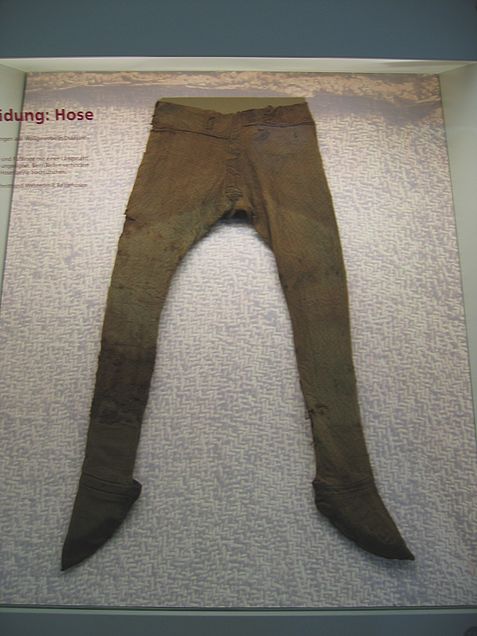
This kind of trousers need a very complicated crotch design to be tight fitting on the leggs, and not rip when you sit down on the ground.
At some point somebody obviously tought "hey, why are we bothering with these complicated and clamy pants? Our tunics are knee length anyhow, so nobdy will see the difference."
"this [fight] looks curious, almost like a game. See, they are looking around them before they fall, to find a dry spot to fall on, or they are falling on their shields. Can you see blood on their cloths and weapons? No. This must be trickery."
-Reidar Sendeman, from King Sverre's Saga, 1201
|
|
    |
 |
Chuck Russell

|
 Posted: Wed 31 Mar, 2010 3:32 am Post subject: Posted: Wed 31 Mar, 2010 3:32 am Post subject: |
 |
|
|
you have to watch the thorjberg pants. people use those to date pants from celt to 11thc because there's nothing in between as far as finds. i have seen them dated a lot earlier than 8th century. also, these pants are very wide at the top. thus the belt loops. i have made a reconstructed pair and had to make the spread in the backside and waist a lot larger as to not rip them. they do feel great when you have them on though.
|
|
    |
 |
Troy G L Williams

|
 Posted: Wed 31 Mar, 2010 6:17 am Post subject: Posted: Wed 31 Mar, 2010 6:17 am Post subject: |
 |
|
Another question on the same lines. Did the pants have integrated feet or not? If not, then what was worn in lieu? Socks? 
v/r,
Troy Williams
"It’s merely a flesh wound." -Monty Python and the Holy Grail
|
|
  |
 |
Sean Flynt

|
|
   |
 |
Sean Flynt

|
 Posted: Wed 31 Mar, 2010 7:03 am Post subject: Posted: Wed 31 Mar, 2010 7:03 am Post subject: |
 |
|
Alternatives from the late 1460s. These clearly are not "tight," as they have wrinkles and are rolled just as we would roll trouser legs today (compare to the more traditional-looking hose on the figure at right). They must have some stretch, however, because the cuffs would not appear to be as wide as a thigh. Note that they are not joined to a foot (as the later Bundhose appear to be,) and are shown worn with calf-height boots. Austrian or Slovakian. There are several depictions of these and it seems that they were associated with lower social classes--peasants, common soldiers/militia.
In the second image below, the figure at right appears to be wearing a pair of Levi's 501 jeans. Perhaps he's just come back to work after a morning down at the fishin' hole. Maybe he has a sack of crawdads waiting for lunch.
 Attachment: 202.41 KB Attachment: 202.41 KB
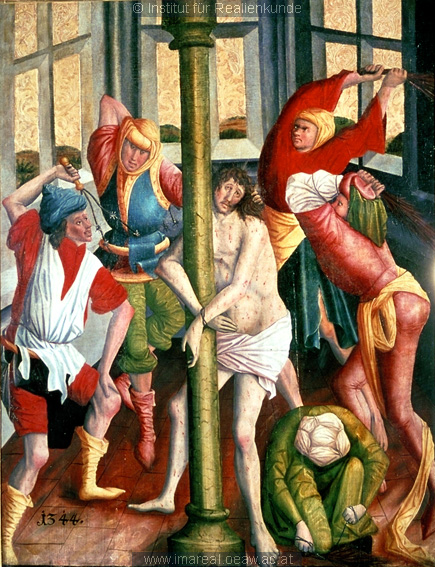
 Attachment: 215.35 KB Attachment: 215.35 KB
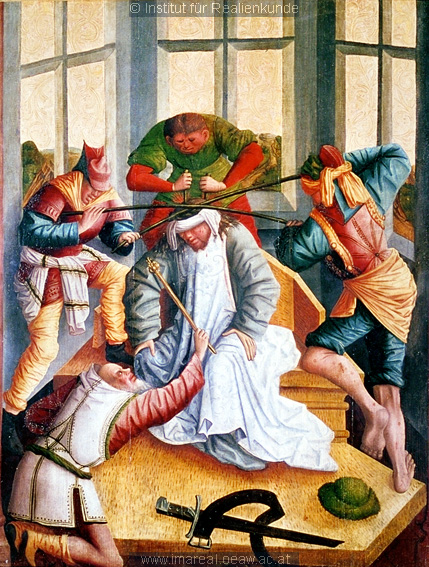
-Sean
Author of the Little Hammer novel
https://www.amazon.com/Little-Hammer-Sean-Flynt/dp/B08XN7HZ82/ref=sr_1_1?dchild=1&keywords=little+hammer+book&qid=1627482034&sr=8-1
|
|
   |
 |
Elling Polden

|
 Posted: Wed 31 Mar, 2010 4:35 pm Post subject: Posted: Wed 31 Mar, 2010 4:35 pm Post subject: |
 |
|
The conclusion seems to be that unless you are from a total backwater, western europeans wore hose and breeches from at least 1000. The Franks wore them from the 700's, at the least.
The slavs and other eastern peoples used pants all along. There are some posible indications that loose pants where used in heathen scandinavia during the early viking period (7-800s), but by the 900s they have the same sleek leg garments as everybody else.
It was not before the late 1700s that loose fitting pants where reintroduced into western european fashion.
So, no, there's no getting around them 
The hose where suplemented by various accessories, like leg wraps, tall needleboud socks, or aditional outer hose for cold weather use.
Integradet feet seems to have been common. Personally I find that it makes the hose fit a lot better. In dry weather you can even use them without shoes, if they have a hide sole.
"this [fight] looks curious, almost like a game. See, they are looking around them before they fall, to find a dry spot to fall on, or they are falling on their shields. Can you see blood on their cloths and weapons? No. This must be trickery."
-Reidar Sendeman, from King Sverre's Saga, 1201
|
|
    |
 |
Daniel Staberg

|
 Posted: Wed 31 Mar, 2010 5:05 pm Post subject: Posted: Wed 31 Mar, 2010 5:05 pm Post subject: |
 |
|
Pants are worn by all Swedish peasant soldiers in Dolnsteins drawings from 1502, pants also appear in the art of Aertsen & Beuckelaer who were painting in the Netherlands in the mid-16th Century.
Written sources suggest that Swedish peasant dress was distinctly diffrent in cut and appearance from fashionable western clothing. Conscripts were to be dressed in proper soldierly fashion not only to give them a proper appearance but also to make it harder for deserters.
When we once again get detailed drawings by an eyewitness from the later 17th Century the dress of Swedish peasants are basicly unchanged from the time of Paul Dolnstein.
So I'd say that at least in Sweden the use of pants was constant among a large group of the population, church paintings and similar pictorial sources almost certainly tells us more about how the artist wanted to depict people, an ideal rather than a snap shot of the local parishoners. Many, painters were foreigners and would have seen no reason to pain the crude and outlandish clothing of the backwards Swedes but rather prefered to follow the style of clothign and paintign they were comfortable with from their native countries.
"There is nothing more hazardous than to venture a battle. One can lose it
by a thousand unforseen circumstances, even when one has thorougly taken all
precautions that the most perfect military skill allows for."
-Fieldmarshal Lennart Torstensson.
|
|
  |
 |
|
Mikael Ranelius
|
 Posted: Thu 01 Apr, 2010 10:50 am Post subject: Posted: Thu 01 Apr, 2010 10:50 am Post subject: |
 |
|
Here are the Dolnstein-trousers Daniel was talking about:
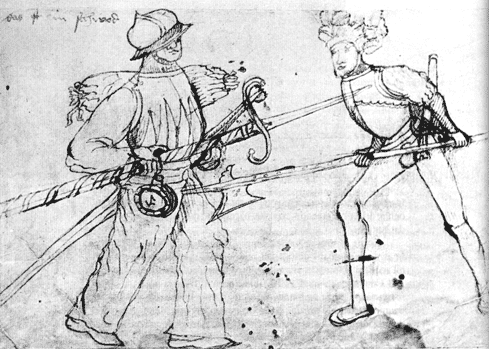
Late 15th century Swedish Church painting:
http://www.rafen.net/byxor/P1010207.JPG
Early 17th century portrait of the 16th century peasant leader Nils Dacke:

Trousers like these made from linen and/ or hemp were worn by rural Dalecarlians in central Sweden as late as the 1890s, in fact they're still part of the traditional summer garb.
IIRC I've seen depictions of similar trousers or ankle breeches worn by sailors in late medieval Dutch art.
|
|
  |
 |
Sean Flynt

|
|
   |
 |
|
Nathan Quarantillo
Location: Eastern Panhandle WV, USA Joined: 14 Aug 2009
Posts: 281
|
 Posted: Thu 01 Apr, 2010 7:18 pm Post subject: Posted: Thu 01 Apr, 2010 7:18 pm Post subject: |
 |
|
well, since I am possibly going for a 15th cent English yeoman archer, (once I get done with the Landsknecht and civil war kits) I would not do well to appear a backwater bumpkin. Hosen it is.....
At least the historical kind arn't as feminine as everyone thinks they are (quite manly if one asks me)...... 
but on another medieval fashion note, were big hooded cloaks used? theyre everywhere in medievalesque modern garbage, but what about in the period? Based on reality? Seems to me that a big friggin wool cloak would be quite practical, even if by the soldierly and such......
 Attachment: 16.16 KB Attachment: 16.16 KB
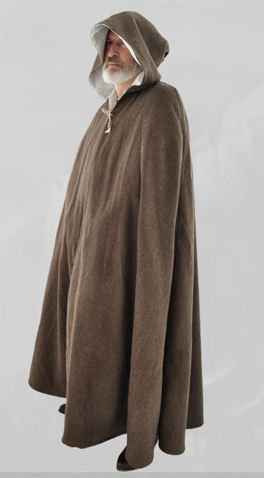
Stereotypical medieval cloak. Modern invention?
“He who has a why to live for can bear almost any how.” ― Friedrich Nietzsche
|
|
  |
 |
|
Mikael Ranelius
|
 Posted: Thu 01 Apr, 2010 8:22 pm Post subject: Posted: Thu 01 Apr, 2010 8:22 pm Post subject: |
 |
|
Cloaks were normally hoodless and semicircular throughout the European Middle Ages. Granted, some period art suggest that hooded cloaks might have been worn, but if so they seem to have been comparatively rare. The full-circle, hooded cloak came into fashion for women’s wear during the 18th century, otherwise I’d say its contemporary prevalence owes much to fantasy- and semi-historical LARP. The late 13th century, caftan-like gardecorps sometimes came with an integrated hood, but it’s not a cloak, nor is it appropriate for portraying a 15th century archer.
The mid 14th century Bocksten cloak:
http://www.personal.utulsa.edu/~marc-carlson/cloth/bockclok.html
Example from a late 14th century German effigy. Like the Bocksten man he’s wearing a separate hood and cloak:
http://mainzauber.de/blog09/wp-content/upload...hausen.jpg
|
|
  |
 |
Mark T

|
 Posted: Thu 01 Apr, 2010 9:18 pm Post subject: Posted: Thu 01 Apr, 2010 9:18 pm Post subject: |
 |
|
While it may not be a 'cloak' as such, Gerry Embleton's Medieval military costume (Ramsbury, The Crowood Press, 2000) on page 63 depicts an:
| Quote: | | Officer of the Black Forest infantry contingent in the 1474 campaign, dressed in black and armed with pole-axe and sword. Note the slit sleeves of his hooded overgown. |
Revival Clothing's description of their cloak had a discussion about some of the reasons for separate hoods, including that this can be quite a warm combination (sorry I can't provide the link - the page has disappeared from their site just this week, but will probably reappear in the future). I guess it also gave soldiers flexibility as to whether they wore a hood or helmet ... although the question of where to put your hat/hood while wearing a helmet is one that intrigues me. Embleton & Howe's The medieval soldier has a photo of one with it slung over his shoulder, with the liripipe tucked into his belt, which doesn't seem particularly practical ...
And for what it's worth, the issue of integral hoods vs waterproof hats comes up in hiking/backpacking circles every so often ... while the integral hood can keep rain out of the neck better, anything that pulls down on the jacket - such as a backpack - can pull down uncomfortably on the hood, so some folks argue for a separate hat. I wonder if practical factors similar to this (rather than 'just' fashion) were relevant to the general medieval preference for a separate hood at all?
|
|
  |
 |
Glennan Carnie

|
 Posted: Fri 02 Apr, 2010 1:14 am Post subject: Posted: Fri 02 Apr, 2010 1:14 am Post subject: |
 |
|
There are two things you see very regularly with people new to medieval clothing:
- Tight hose look girly
- Cloaks look nice and warm
Many people never get past these ideas (Hollywood certainly hasn't!). That's why you see so many people wearing baggy pants and hoods at re-enactment events. As has been mentioned above both cloaks and baggy hose are comparatively rare in contemporary evidence; and certainly not commonplace.
Below is a question from a friend on another forum. Rather than repeat myself I thought I'd just post my response (edited slightly):
| Quote: |
I was wondering if you could tell me what an archer of the 14th/15th century would be wearing, either at war or roving? I know this is probably like asking how long a piece of string is, but I was going to have a look for stuff at the Living History Fair on Friday and I don't know too much about the clothing. Not necessarily going to spend a fortune there just trying to get an idea what was authentic.
Any pointers would be appreciated. |
My response:
Medieval clothing was almost universally worn in three layers: underwear, foundation garments and outerwear. To be properly dressed you should have at least underwear and foundation garments; and ideally one item of outerwear. Then there are the accessories.
There's actually a big difference between the 14th and 15th centuries. As an example, let's take Crecy (1346) for the 14thC and Towton (1461).
For Crecy:
Underwear: linen shirt, linen breeches (basically long, baggy shorts), coif (linen skull-cap)
Foundation: Cote (knee-length long-sleeve tunic), single-leg hose (tied to the breeches by a single lace)
Outerwear: Surcote (same as the cote, but bigger and often short-sleeved), hood (with long mantle; or short for an archer)
Accessories: belt (thin), small ballock purse, low shoes or ankle boots, knife (ballock or basillard)
For Towton:
Underwear: linen shirt, braies (linen boxers)
Foundation: Doublet (very short, tight-fitting jacket), joined hose (tied to doublet to hold them up!)
Outerwear: Coat (like a modern wool jacket), hat (knitted or felt)
Accessories: belt (thin), large ballock pouch, low shoes or ankle boots, knife (rondel or ballock knife)
Prices depend on material and quality of finish.
If you're not used to wearing medieval clothing then 14thC is easier to wear as it's not so fitted. 15thC (doublet and hose) MUST be correctly fitted otherwise you won't be able to move (or else you'll look like a saggy sack of sh*t tied up in the middle).
It is easy to get it wrong if you don't know what you're looking for. As an example, you've probably seen the Osprey "English Longbowman" book with the archer wearing the Cheshire/Flint green/white cote on the front. Here are two 'real' versions of that archer:
The first wearing correctly tailored clothing, based on extant finds and extensive research:

And here's a guy supposedly wearing the same thing, but somehow managing to look like he's wearing a medieval leisure suit(!):
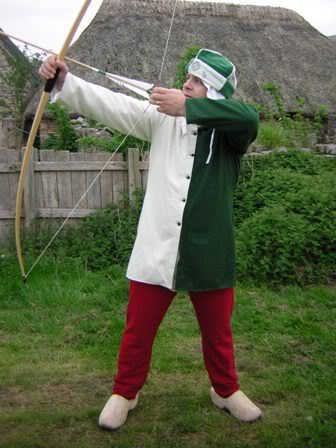
It's worth paying the extra (and it can be as little as 20%) for garments that will be fitted to you properly and period-correct. Otherwise you can spend a lot of money buying exactly the wrong thing (and that's money wasted).
|
|
  |
 |
|
Nathan Quarantillo
Location: Eastern Panhandle WV, USA Joined: 14 Aug 2009
Posts: 281
|
 Posted: Fri 02 Apr, 2010 11:02 am Post subject: Posted: Fri 02 Apr, 2010 11:02 am Post subject: |
 |
|
Lol, is the fail green archer wearing clogs?   
and I get what you are saying glennan. And I've already got around the hose thing, just confirming suspicions about the cloak. (you have to admit, it sounds quite warm)
hhhmmm... what do you think is cheaper and eisier to do well? a late 14th cent or early-mid 15h cent yeoman archer?
“He who has a why to live for can bear almost any how.” ― Friedrich Nietzsche
|
|
  |
 |
|
Mikael Ranelius
|
 Posted: Fri 02 Apr, 2010 12:15 pm Post subject: Posted: Fri 02 Apr, 2010 12:15 pm Post subject: |
 |
|
| Nathan Quarantillo wrote: | Lol, is the fail green archer wearing clogs?   
and I get what you are saying glennan. And I've already got around the hose thing, just confirming suspicions about the cloak. (you have to admit, it sounds quite warm)
hhhmmm... what do you think is cheaper and eisier to do well? a late 14th cent or early-mid 15h cent yeoman archer? |
A 15th century kit will require less material, but calls for more advanced tailoring, especially if you go for the joined hose. Clothes in general would have been pretty simple in the 1340s, being made up by square widths of cloth and gores rather than carefully shaped pieces (except for hosen).
|
|
  |
 |
|
Lafayette C Curtis
|
 Posted: Sun 04 Apr, 2010 4:32 am Post subject: Posted: Sun 04 Apr, 2010 4:32 am Post subject: |
 |
|
| Nathan Quarantillo wrote: | At least the historical kind arn't as feminine as everyone thinks they are (quite manly if one asks me)......  |
Bah! Hose--especially the really close-fitting kind--is probably going to be the most masculine piece of garment in your closet if you have the legs for it. It appears that many men nowadays would look silly in it simply because they don't exercise enough to do their hosen justice.
|
|
  |
 |
|
Lafayette C Curtis
|
 Posted: Sun 04 Apr, 2010 4:42 am Post subject: Posted: Sun 04 Apr, 2010 4:42 am Post subject: |
 |
|
| Mikael Ranelius wrote: | Early 17th century portrait of the 16th century peasant leader Nils Dacke:

Trousers like these made from linen and/ or hemp were worn by rural Dalecarlians in central Sweden as late as the 1890s, in fact they're still part of the traditional summer garb.
IIRC I've seen depictions of similar trousers or ankle breeches worn by sailors in late medieval Dutch art. |
You know, this reminds me of the similar trousers (very loose and gathered below the knee) worn by medieval Chinese soldiers. One reason that has been proposed for the design is that it allowed garments to be made in a very large one-size-fits-none method and then each individual wearer could tailor the length by changing the amount of cloth bloused up over the knee garters/gathers.
Of course, when you're used to hose, such peasant trousers suddenly look quite effeminate in comparison!
|
|
  |
 |
|
|
You cannot post new topics in this forum
You cannot reply to topics in this forum
You cannot edit your posts in this forum
You cannot delete your posts in this forum
You cannot vote in polls in this forum
You cannot attach files in this forum
You can download files in this forum
|
All contents © Copyright 2003-2025 myArmoury.com — All rights reserved
Discussion forums powered by phpBB © The phpBB Group
Switch to the Basic Low-bandwidth Version of the forum
|

